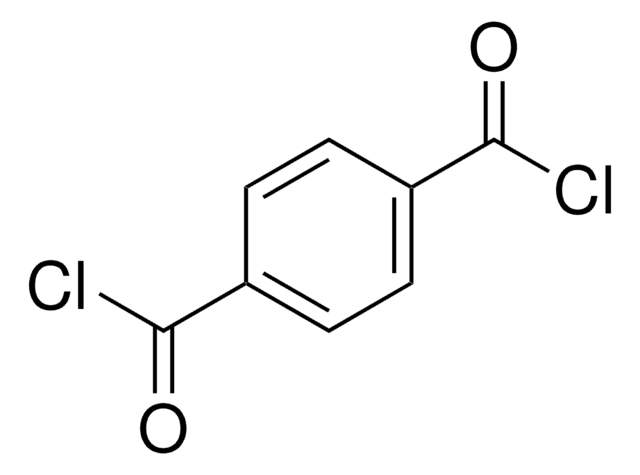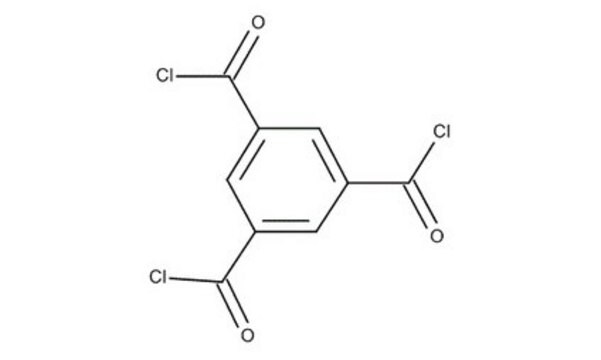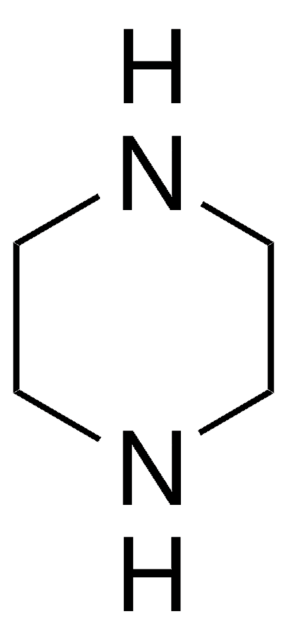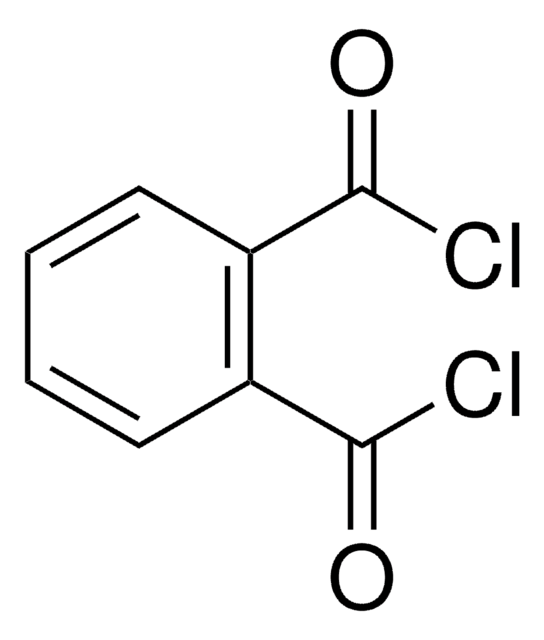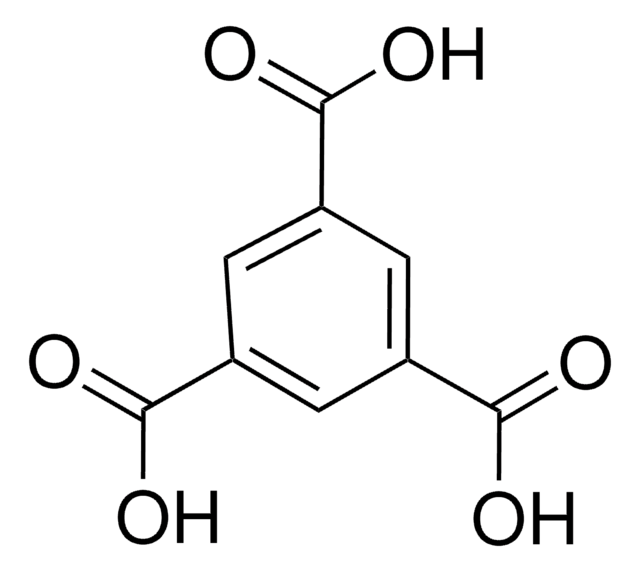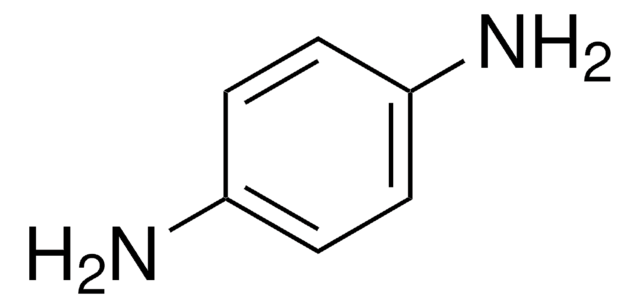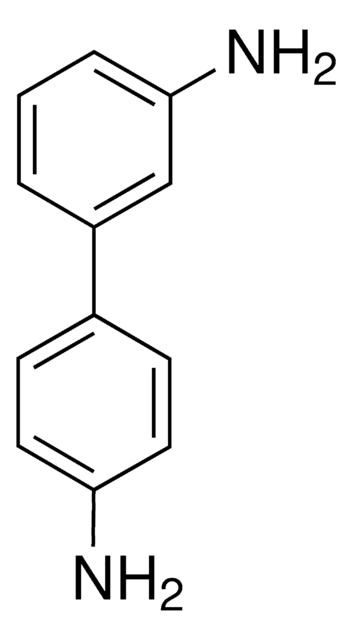147532
1,3,5-Benzenetricarbonyl trichloride
98%
동의어(들):
Benzene-1,3,5-tricarbonyl chloride, Trimesic acid trichloride, Trimesoyl chloride
로그인조직 및 계약 가격 보기
모든 사진(6)
About This Item
Linear Formula:
C6H3(COCl)3
CAS Number:
Molecular Weight:
265.48
Beilstein:
2940936
EC Number:
MDL number:
UNSPSC 코드:
12352100
PubChem Substance ID:
NACRES:
NA.23
추천 제품
Quality Level
분석
98%
형태
solid
bp
180 °C/16 mmHg (lit.)
mp
32-38 °C (lit.)
solubility
chloroform: soluble 10%, clear to very slightly hazy, colorless to faintly yellow
density
1.487 g/mL at 25 °C (lit.)
SMILES string
ClC(=O)c1cc(cc(c1)C(Cl)=O)C(Cl)=O
InChI
1S/C9H3Cl3O3/c10-7(13)4-1-5(8(11)14)3-6(2-4)9(12)15/h1-3H
InChI key
UWCPYKQBIPYOLX-UHFFFAOYSA-N
유사한 제품을 찾으십니까? 방문 제품 비교 안내
일반 설명
1,3,5-Benzenetricarbonyl trichloride reacts with propargyl alcohol to yield triprop-2-ynyl benzene-1,3,5-tricarboxylate.
애플리케이션
1,3,5-Benzenetricarbonyl trichloride was used in the synthesis of chiral azoaromatic dendrimeric systems. It was used to study the structure of activated composite membranes containing organophosphorus extractants as carriers. It was the starting material for two tritopic amides derived from 3- and 4-methylaminopyridine which self-assembled into nanoballs on treatment with palladium(II) nitrate in DMSO.
신호어
Danger
유해 및 위험 성명서
Hazard Classifications
Eye Dam. 1 - Skin Corr. 1B - Skin Sens. 1
Storage Class Code
8A - Combustible corrosive hazardous materials
WGK
WGK 3
Flash Point (°F)
230.0 °F - closed cup
Flash Point (°C)
110 °C - closed cup
개인 보호 장비
Eyeshields, Faceshields, Gloves, type P3 (EN 143) respirator cartridges
이미 열람한 고객
Behnam Khorshidi et al.
Scientific reports, 8(1), 784-784 (2018-01-18)
The development of nano-enabled composite materials has led to a paradigm shift in the manufacture of high-performance nanocomposite membranes with enhanced permeation, thermo-mechanical, and antibacterial properties. The major challenges to the successful incorporation of nanoparticles (NPs) to polymer films are
Zhe Yang et al.
Environmental science & technology, 52(16), 9341-9349 (2018-07-26)
Conventional thin-film composite (TFC) membranes suffer from the trade-off relationship between permeability and selectivity, known as the "upper bound". In this work, we report a high performance thin-film composite membrane prepared on a tannic acid (TA)-Fe nanoscaffold (TFCn) to overcome
Dangchen Ma et al.
ACS applied materials & interfaces, 9(8), 7523-7534 (2017-02-12)
Zirconiumv (IV)-carboxylate metal-organic framework (MOF) UiO-66 nanoparticles were successfully synthesized and incorporated in the polyamide (PA) selective layer to fabricate novel thin-film nanocomposite (TFN) membranes. Compared to unmodified pure polyamide thin-film composite (TFC) membranes, the incorporation of UiO-66 nanoparticles significantly
Zhikan Yao et al.
Journal of colloid and interface science, 552, 418-425 (2019-06-01)
This study reports highly permeable ultrathin film composite (uTFC) membranes whose rejection layer was reinforced by polymer chains during the interfacial polymerization of trimesoyl chloride (TMC) and m-phenylenediamine (MPD) to achieve enhanced salt rejection. A rejection layer of approximately 20 nm
Ke Zheng et al.
Scientific reports, 8(1), 10022-10022 (2018-07-04)
A low-cost sulfonated polysulfone (SPSU)/poly(vinyl chloride) (PVC) substrate based high-performance thin-film composite (TFC) forward osmosis (FO) membrane was fabricated in this work. The results showed that the morphologies of the substrates were looser and more porous, and the porosity, pure
자사의 과학자팀은 생명 과학, 재료 과학, 화학 합성, 크로마토그래피, 분석 및 기타 많은 영역을 포함한 모든 과학 분야에 경험이 있습니다..
고객지원팀으로 연락바랍니다.